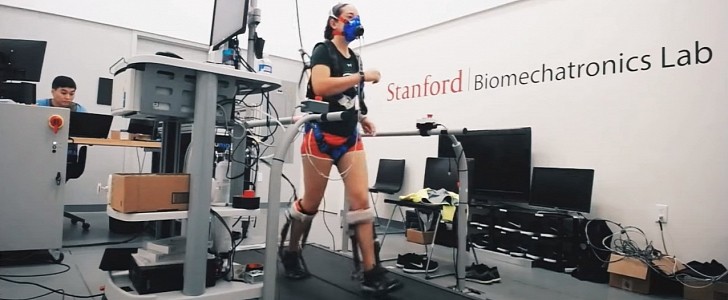Stanford engineers came up with an ankle exoskeleton that can help people pick up the pace and increase their walking speed by 40 percent.
As we age, so do our walking abilities, which can be a frustrating truth to cope with. Walking at a normal speed becomes unattainable, as our muscles weaken and fatigue sets in quicker.
But Stanford engineers may have a solution to this problem, as they are ambitiously experimenting with a groundbreaking device: a smart ankle exoskeleton system controlled by an algorithm.
They are currently running experiments with a prototype exoskeleton that is attached to the shin and into a running shoe. It is powered by motors and can only work inside the lab. For now.
Researchers tested the device on 10 healthy participants in several scenarios: with or without the exoskeleton attached, in normal or running shoes, with the machine turned on or off. They also optimized it in various ways, for speed, energy use, and more.
The results of their tests were published in a paper in IEEE Transactions on Neural Systems and Rehabilitation Engineering. The participants had to walk on a treadmill with the device attached to their ankle, while the exoskeleton’s settings were continuously adjusted.
The results of the experiment were very encouraging. When the exoskeleton was optimized for speed, it increased the subjects’ walking speed by approximately 42 percent. The algorithm required around 150 rounds of adjustments (two hours per person), in order to achieve this result. And even though the engineers were primarily focused on improving the participants’ speed, they also noticed an increase in efficiency:
“The study was designed to specifically answer the scientific question about increasing walking speed […] We didn’t care too much about the other performance measures, like comfort or energy. However, seven out of ten participants not only walked faster but consumed less energy, which really shows how much potential exoskeletons have for helping people in an efficient way”, explained Seungmoon Song, a postdoctoral fellow in mechanical engineering and lead author of the paper.
But Stanford engineers may have a solution to this problem, as they are ambitiously experimenting with a groundbreaking device: a smart ankle exoskeleton system controlled by an algorithm.
They are currently running experiments with a prototype exoskeleton that is attached to the shin and into a running shoe. It is powered by motors and can only work inside the lab. For now.
Researchers tested the device on 10 healthy participants in several scenarios: with or without the exoskeleton attached, in normal or running shoes, with the machine turned on or off. They also optimized it in various ways, for speed, energy use, and more.
The results of their tests were published in a paper in IEEE Transactions on Neural Systems and Rehabilitation Engineering. The participants had to walk on a treadmill with the device attached to their ankle, while the exoskeleton’s settings were continuously adjusted.
The results of the experiment were very encouraging. When the exoskeleton was optimized for speed, it increased the subjects’ walking speed by approximately 42 percent. The algorithm required around 150 rounds of adjustments (two hours per person), in order to achieve this result. And even though the engineers were primarily focused on improving the participants’ speed, they also noticed an increase in efficiency:
“The study was designed to specifically answer the scientific question about increasing walking speed […] We didn’t care too much about the other performance measures, like comfort or energy. However, seven out of ten participants not only walked faster but consumed less energy, which really shows how much potential exoskeletons have for helping people in an efficient way”, explained Seungmoon Song, a postdoctoral fellow in mechanical engineering and lead author of the paper.


